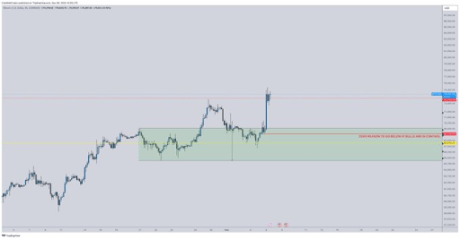Coinbase Insights: The Double-Edged Sword of Bitcoin ETFs in 2024


The post Coinbase Insights: The Double-Edged Sword of Bitcoin ETFs in 2024 appeared first on Coinpedia Fintech News
The impending launch of spot Bitcoin exchange-traded funds (ETFs) in the U.S. holds the potential to introduce two significant challenges, highlighted by Coinbase researchers in a recent podcast.
Insights from Coinbase Researchers
According to Coinbase’s David Duong, head of institutional cryptocurrency research, in his 2024 cryptocurrency market forecast report, cryptocurrency market capitalization has more than doubled this year, signaling the end of the “crypto winter.” He believes the industry needs to focus on building a reliable and innovative cryptocurrency ecosystem.
Duong predicts institutional investors will continue focusing on BTC in early 2024. BTC’s price may rise due to factors like the upcoming BTC halving, U.S. interest rate policy changes, and concerns about commercial real estate.
Bitwise predicts a spot Bitcoin ETF could be the most successful ETF launch ever. Duong, on the other hand, views the sourcing challenge as a positive sign despite high demand. He also anticipates that BTC may outperform traditional asset classes. Duong highlights the two potential impacts of a BTC spot ETF approval in the U.S., which could lead to significant market changes by lowering the investment threshold and attracting more institutional investors as cryptocurrency regulations evolve.
No Risk, No Gain!
The first concern centers around a potential shortage of “regulated” Bitcoin supply needed to support the ETFs. Institutions responsible for the ETFs may face difficulties acquiring enough Bitcoin from regulated sources due to overwhelming demand, raising questions about their ability to meet the necessary Bitcoin requirements.
Although this increasing demand for Bitcoin is great, Duong noted that the market must consider the shortage of Bitcoin from regulated channels. Sutton noted the 2nd risk of the “basis trade.”—a prominent institutional trading method. This method exploits Bitcoin’s spot price-futures contract differential. The rise in spot Bitcoin and futures trading volume has increased basis trade profitability to 20% in recent weeks.
However, the launch of spot ETFs granting institutional investors direct exposure to Bitcoin may cause the basis to narrow significantly. This narrowing spread could substantially reduce the profitability of the basis trade, affecting this trading strategy’s appeal among institutional investors.
SEC’s ETF Prospects and Grayscale’s Move, Full of Surprises?
Presently, 13 applications for spot Bitcoin ETFs are pending with the Securities and Exchange Commission (SEC). Analysts forecast potential approval as early as January 10, with estimations by Bloomberg’s Eric Balchunas and James Seyffart indicating a 90% chance of approval.
On the flip side, Seyffart’s latest update spilled the beans on a Grayscale twist. The crypto giant is rallying for in-kind redemptions, waving them as the better alternative over cash creation. Why? Because it could make life easier and cheaper for ETF issuers. A smart move, right?
As the crypto community awaits potential ETF approvals, these highlighted risks could significantly impact Bitcoin markets and institutional trading strategies, prompting a cautious outlook among market participants.

